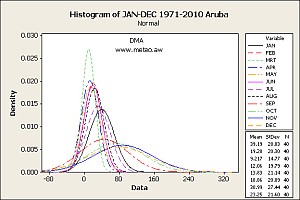Climate Data Aruba
Aruba's aerodrome reference point is at 12.30N 70.00W. Aruba is situated
in the so called Southern Caribbean Dry Zone, and is characterized by tropical
steppe, semiarid hot climate (BSh) (scheme of modified Koeppen System), with a
discernible dry and rainy season, and sustained moderate to fresh easterlies.
The dry season runs roughly from February through June, and the rainy season
starts in September and ends in January. Rain showers occur usually during the
early morning hours, and during our rainy season it can be in the early
morning or early to late evening hours. The lowest average cloud cover
is in the month of February and the highest average cloud cover is in
the month of May, mainly due to upper-level clouds. On daily basis the
average cloudiness of the sky is the highest in the morning hours and
the lowest in the late evening. Aruba, is on the southern fringes of the
Hurricane belt. Only once every 100 years considerable damage is caused by
tropical cyclones passing just south of Aruba. Although tropical cyclones
or mid-latitude storm systems passing to our north can cause some damages
also due to beach erosion and coastal flooding.

| Climate Report 2010, |
Climate Report 2011, |
Climate Report 2012, |
Climate Report 2013, |
Climate Report 2014, |
| Climate Report 2015, |
Climate Report 2016, |
Climate Report 2017, |
Climate Report 2018, |
Climate Report 2019, |
| Climate Report 2020, |
Climate Report 2021, |
Climate Report 2022, |
Climate Report 2023, |
Climate Report 2024, |
| Climate Report 2025, |

